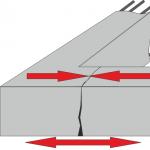Contrary to popular belief, comics aren't just for kids. Comics can tell a story in a truly unique way, by adding emotional images, you can break through the comic to the reader's soul with great success. As a rule, only those who can draw can create their own comics. However, now with the advent of special online generators for creating comics, this statement is not relevant. Anyone can create comics!
Use one of the suggested generators below and create your own personalities and interesting stories. So, let's look at 10 tools for creating comics online:
- Create comics with Marvel
Marvel Comics or Marvel Worldwide Inc. is an American comic book publisher. In this generator you can easily create comics, add characters, objects, backgrounds, conversation bubbles. Unfortunately, adding text in Russian will not work, since the fonts offered on the site do not support Cyrillic. - Bitstrips
It will help you create a cartoon version of yourself. Create your own character. You can embed it as a gmail mail. The service also offers a lot of cartoons for various occasions - for example, for birthday greetings, declarations of love and other important events.
See also what programs can be used for - MakeBeliefsComix.com
The service will help you quickly create your own picture with characters and dialogues. However, like the Marvel generator, there is no support for the Russian language.
- ToonDoo
Registration is required to use this service. ToonDoo gives free rein to your imagination. There is not only a gallery of ready-made characters here, but with the help of, you can create your own characters. In addition, on the service you can use your own photos and change them to your liking.
- Comic Master
Comic Master — website created using flash technologies. This service will help you create comic book characters and invent stories with them. Registration required. Again there is no support for the Russian language ((
Chogger - No registration required, simple operation, you can sign in Russian, you can add a photo from your computer or even take a picture from your webcam.

- Pixton
Registration or authorization via facebook or google account is required. Simple generator. Click on the Pencil icon in the top left corner and start creating your story.
- Witty comics
Inscriptions in Russian and the extraordinary ease of creation.
Create frames. Use a ruler to create a frame. Use the correct paper. For panels with non-standard angles and those that do not fit into the overall context, use separate sheets. You will be able to merge them after scanning.
Start adding content to the frames. Draw in such a way that it is easy to erase or correct details later. Continue until you reach the final end.
- Make sure you leave enough space for dialogue. Designate clouds, rectangles and other test designs.
Circle the final version. Most comic book creators trace the pencil with a pen. Then the pencil is erased. Take your time and edit your work carefully.
- Add dialogs if you want to make the text handwritten. Make the necessary adjustments when adding. Perhaps you will have new ideas when you transfer everything to comics. Think it over well.
Scan the comic. Once you've finished tracing, you can scan the comic to your computer. This will help you to add printed dialogues and also color the pictures if you want. It also makes it easier to publish online.
Clean up the image. Once you've scanned the comic, you can remove minor errors with Photoshop. Also, you can add extra shadows or thick lines.
Create your own font. One way to make your comic stand out from the rest is to use a custom font. There are many programs available on the Internet to create a personal font. One of the most popular is FontCreator.
- When creating a typeface, consider both visual and writing styles. You can use different fonts for each character, but too much font variation is more likely to be distracting and annoying.
Add dialog boxes and text clouds in Photoshop.
- First comes the text layer on top, then the speech cloud, and then your drawing.
- Go to the blending options of the speech cloud layer by right-clicking on it and selecting the desired item. Different modes allow you to give the cloud a different contour. Select "Stroke" and set the following options:
- size: 2 pixels;
- position: inside;
- blend mode: normal;
- opacity: 100%;
- stroke type: color;
- black color.
- Enter text on the text layer. This text will be inside the speech cloud. You can use your own font or a font from the list of available ones. Comic Sans is the most popular.
- Select the speech cloud layer. Use the Oval Marquee tool to create a cloud around the typed text. Place the cursor in the center of the text, and while holding the Alt key, evenly stretch the selection area.
- Use the Rectilinear Lasso tool. Hold down the Shift key and create an acute triangle in the selected area.
- Fill the foreground with white.
- Press Alt+Del to fill the selection on the speech cloud layer. An outline will be automatically created; on this work on the speech cloud can be considered completed.
What for? For fun!
To date, the creation of comics, for example, web strips of three to five panels, is one of the easiest ways to express yourself. Comics are not only drawing training, but also a simulator for structural thinking. It’s not enough to come up with a story, it needs to fit into a limited number of squares on paper or a monitor screen. In the film industry, no director or cinematographer would shoot without a storyboard. All in all, if becoming a comic book creator isn't your goal, think of it as training your storytelling skills.

Frame from the cartoon "Super Prison"
Timing
Before calculating the time, we had to answer ourselves the main question: “Where to start”? As the great animators say (we will constantly use the experience of colleagues - animators Walt Disney , Terry Gilliama and great comic book creator Stan Lee), you can come up with a cartoon in different ways: you can create a deep world, and characters will crystallize out of it by themselves (as in Super Jail), you can throw in various ideas and mix them (this is what Satoshi Kon did when he assembled the Paranoia Agent series from ideas, not included in the full-length cartoons), or you can start with the development of characters.

One of the first incarnations of Mickey Mouse
The young Walt Disney took the third path. He first designed Oswald the rabbit, and when the rights to use this image were taken away, he created the world famous Mickey Mouse. Around Mickey Mouse or any other bright character - the Simpson family, Bugs Bunny, Lupin, Spongebob, Rena and Stimpy - stories are born by themselves. In addition, a bright character (following the example of the Disney empire) can be used for merchandising, and we have been planning to make new stickers for the site for a long time.
Half a week was spent on character development: a brainstorm day, when each member of the editorial staff came up with their own character, and two more days of careful rendering. The next day the editors spent on developing the plot, and the illustrator on the sketch, composing the composition and arranging the boxes. When the sketch was ready, the illustrator took up the digital sketch and the drawing itself, which took another two days. By the evening of the seventh day, the comic was ready.

Characters from the cartoon "Ugly Americans"
References
Animation that will be interesting to watch and adults, and children, airs today on Nickelodeon, Cartoon Network and Disney Channel. Adventure Time creator Pendleton Ward says his parents are constantly thanking him because they now have a cartoon that is fun to watch with kids. We decided to take an ironic and slightly naive tone, like in Adventure Time.




To begin with, we agreed on how our characters would look. We chose between manga, superheroes, European (The Adventures of Tintin) comics and American underground (Ghostworld, Scott Pilgrim). We chose the latter: the main references were the series Ugly Americans and King of the Hill. Characters don't have to be similar - thanks to their difference, we will be able to make an infinite number of strips in the future that will reveal the character and history of each.
With this thought, lightness came: before my eyes was a frame of cartoon David O'Reilly, when residents of completely different, at first glance, worlds ride the subway.
Below is what we got:

Characters we created
Character development
During the brainstorm, we were guided by the advice of geniuses:: “I took a nap, and my friend Pat urgently needed to know what the people in the Grasslands area look like. He woke me up for a long time and when he pushed me, I told him: “I can tell you what I dreamed about. People in Grasslands look like they are at home with arms and legs.” That's how they came about." We were not afraid to say stupid things and carried any nonsense that came to mind. They didn’t forget that many characters in cartoons and comics are invented, remembering the features of their friends and acquaintances (for example, the creator took the image of her brother as a basis), so the characters are copied from members of the editorial board.
We weren't afraid to say stupid things
and draw heroes
from members of the editorial board

Character Sketch
Artyom LUCKO recently had a wedding - this is how a bearded princess appeared, Faraj Efendiev's hair resembles a fireball, Andrey Gerasimchuk loves video games and became a soldier, and Anya and Dasha were on vacation, so without thinking twice, we created a two-headed girl. We came up with a few characters (a carton of milk or an airship) by chance and then adjusted them to fit the employees.
How to design characters so that
they didn't turn out the same
Characters like a carton of milk can be the driving force behind the plot. A carton of milk is like Kenny from South Park, silent, tragic and lost. In the next comics, for example, other heroes will be able to look for him. Or, like Beamo from Adventure Time, he can dig in and look for himself.
The airship is both a character and a vehicle, which is also a traditional technique: think of the swan geese, Jake from Adventure Time, the magic school bus, the car from Knight Rider, or the cat bus from the cartoon My Neighbor Totoro.

Villains from X-Men

Team "P" from "Pokemon"

Hellboy Nazi villains
Plot
When the characters were ready, the editors began to develop the plot. The stories of each individual character were well thought out, but creating something that would unite everyone on one page turned out to be more difficult. Here the simplest idea came to our aid: to take an ancient, like the world, plot about the struggle between good and evil and change it a bit.
It is generally accepted that Aristotle set the standards for narration and plot development in the first part of his Poetics, dedicated to tragedies in the Greek theater. If we do not take into account the paraphernalia of ancient drama, such as the choir or the god from the machine, the plot can be generalized to the plot, the development of the plot (twists), climax and denouement.
No matter what absurd motive the evil guys have, the main thing is that it is global
The main thing is not to immediately create a masterpiece, rather than retreat from your idea, any result is already a result, and further it will drive us to create more and better. When good wins, it's not interesting, besides, our comic has just begun, and as you know, good wins at the very end of a fairy tale. It has only just begun for us. Let good lose.

Comic title and logo
In parallel with the work of the illustrator, we thought about the title: no need to be afraid to suggest the most idiotic, otherwise the name will not appear at all, so we took the stupid “Legends of Lukatmi”, which we then reduced to the neutral the lams. Lams were reminded of llamas, so the plot got a core - bad guys stole from good llamas, bewitched and now guard the castle with their help. They are going to steal all the llamas on Earth. It doesn't matter what absurd motive the evil guys have, the main thing is that it is global. We've seen funny bad guys in a dozen movies we grew up watching, from Gary Oldman in The Fifth Element to Shredder in Teenage Mutant Ninja Turtles and Dr. Evil in the Austin Powers series.
Process


What You'll Be Creating
In this tutorial, we'll take a look at the process behind creating a comic page. We'll focus on how you can turn your comic book idea into a visual story, making it easy and enjoyable to read using different types of panels and perspectives.
We can make your workflow in Adobe Illustrator fast and convenient with clipping masks to create panels, and the Effect menu to create wavy panels in no time.
1. Create a storyboard
Once you have a character and an idea that you want to convey, it's tempting to dive headlong into drawing. If you take the time to plan out the story and structure of your comic, you will avoid drawing dead ends.
Step 1
It's hard to create a comic if you don't have anything to say, so the first step is to come up with a sequence of events. Storytelling is an art form in its own right, and I won't get into it too much now, but here are some tips for organizing your ideas and turning them into a visual story.
For example, I'll be using my little chef character from the previous tutorial to create a little comedy comic. I want to portray her as cheerful, but clumsy, so she will have a few mishaps in the kitchen, which she will try her best to fix.
I'll start by creating a list of what could have happened to her and how one action could lead to another. To do this, I sketch everything that comes to mind on paper, but if printing on a computer is more suitable for you, you can use the appropriate program. Convenience is important when brainstorming.
Step 2
When interesting ideas come up, try to distribute events by thinking about the pace of your story. Different tempo suits different types of stories. Some may start with a tight turn and then continue at a relaxed pace. If you are creating a long story, there are many sources on the Internet that tell you how to build a classic story model for drama. My story will have a peaceful beginning with a transition to a chaotic scenario where one trouble follows another.
Script Example
- Show the scene - the kitchen.
- Show the chef at work.
- She dreams of winning a prize.
- Suddenly she drops something into the food.
- Moves away to take something; the food starts bubbling and smoking.
- When she returns, the food is smoking heavily, leaving her in shock.
- She takes the bowler hat and runs away with it.
For this guide, I will only take the first page of the comic. Although it is short and simple, I will write the script for myself. It doesn't have to be anything special and can simply consist of a list of actions. I will need time to write it down and clarify what exactly I will be drawing.
Step 3
With the script written, even if it is simple, it will be more convenient to proceed to the next step. Now that we have all the necessary actions written down, it's time to turn the words into pictures. Try to draw the actions from the script using simple stick figures. Don't try to make them perfect - the important thing is that your story will be as clear on the pictures as it is on a piece of paper.
At this stage, it often becomes clear that some necessary details are missing in the script, or that some points are good only in the text, but not in the pictures. The script is not the law, so you can go back to it to change something you don't like. At this stage, I like to make a lot of sketches and comment on them from the side.
I usually keep storyboard pages very small. If there are many pages in the layout, it is easier to make a general impression. Some people like to create storyboards the size of a completed comic. You can also try this method to see what works best for you.
2. Choosing the right type of panels
Once we have the script in place, we need to focus well on the look and feel we want to give to the story. Comics come in a wide range of formats, from one-page newspaper comics and graphic novels to online comics that can be scrolled almost endlessly. In my case, it will be something a little longer than a newspaper strip, but will not take more than a couple of pages. Both horizontal and vertical pages work, but I use vertical ones.
Step 1
All over the world there are different styles of comics, not only in the form of drawings, but also in the form of layouts. The empty spaces between comic panels are commonly referred to as "grooves" and are often used in Western comics. One or more panels without grooves are used in a separate type of layout often used in Japanese comics (manga).
The shapes of the comic book panels also vary. It doesn't have to be regular squares and rectangles. A round, star-shaped, or wavy panel can create a different feel or convey information to the reader. For example, a wavy panel is often used to convey a moment of fantasy, dream, or memory, rather than the current narrative.
The size of the panel can also change the atmosphere of the comic. A very long panel with ample space can create a feeling of slowness. Several small panels next to each other will give a sense of great speed in the development of events.
Step 2
As you draw the content in the box, imagine that you are the operator. Depending on the angle of the camera, everything that is in the frame will look a certain way. When the camera is shooting from below, this is called "frog perspective" and is often used to give characters a powerful look. The top view is called "bird's eye view" and is used to make the character look smaller and more defenseless.
In the comics, there is an expression "talking head" where the characters talk a lot and the panels only show talking heads. It is not uncommon for newspaper comics to have similar panels with only two characters talking.
When creating longer narrative comics, it will be better if the "camera" moves around. Close-ups, full-length shots, and bird-and-frog perspectives can make all the difference, even if there are only two talking characters.
Step 3
It doesn't matter what kind of comic you create, because the key is always clarity. The reader should not be puzzled by the question of which panel to start reading from or what is happening. When you use different angles, make it clear which characters are talking and where we're watching them from.
A great tool for this is the 180 degree rule. It is often taught in film theory, but it can also be applied to comics. This is an imaginary line that the camera does not cross. This way the camera can move from one side to the other without mixing characters. The left character will constantly spawn on the left side, even if the camera is in front of or behind them.
Although this is a rule, it does not mean that it cannot be broken. Think of it as a tool to help you, not something you constantly have to follow.
3. Clipping Masks to the Comic Panels
I've created a sketch for the comic page, it's time for the layout. Even after you've planned out your comic, as you draw, you may still want to change things. Clipping masks are great for this. Here I'll walk you through how clipping masks work in Adobe Illustrator and how they can be used when creating comics.
Step 1
Let's start by opening a new A4 document in Illustrator. From the File menu I choose " Post» to import my sketch to Artboard. You may notice a large X on top of the image. It is needed in order to show that the picture is linked, but not embedded in the document. This means that if you need to move an image file, Illustrator will not be able to load the image.
Step 2
Under the top menu you will find buttons to customize the imported image. If you click on the button " Embed”, Illustrator will make the image part of the document. This will slightly increase the size of the document, but for long projects it comes in handy.
Step 3
With help Rectangle Tool I place the page and panels as placeholders. I choose no fill and blue stroke. The blue is for easier separation of the panels when I move on to coloring.
Step 4
Because I already have a sketch, I can start inking as I see fit. This panel will have a funny expression of shock, so I'll start with that. With help Brush Tool I'll import my ink brush from mine and start painting with long, vigorous strokes. Because we're going to use clipping masks, it doesn't matter if the lines go out of bounds. This will make the drawing process easier and more fun. fewer restrictions.
Step 5
Once the ink painting is done, I select all the vector paths in the panels, not including the frame borders. Then I group them by clicking Command-G I deselect the group by clicking either Command-Shift-A or with the left mouse button outside the selection.
The border of the frame will be our clipping mask, but we also need to stroke the frame with black. Because clipping masks are transparent, the black outline of the frame will not be visible, so we will select the frame itself and create a copy of it by clicking Command-C
Step 6
Here we will add a panel content group to the selection. With everything selected, right-click and select " Create Clipping Mask» in the dropdown menu.
Step 7
Here we will paste the border of the frame we made a copy of earlier by clicking Command-F This will place the border of the frame on top of everything else, and we have our finished panel.
Step 8
What's really really succinct is how easily you can modify comic panels with these clipping masks. Use drag-select one of the anchor points of the mask.
This action (drag-select) will help to select both transparent clipping masks and the black border of the frame at the same time. Now you can drag the anchor points to change the appearance of the frame. The hidden parts of the panel with the pattern will also become visible.
Step 9
Now let's try to change another panel. It should have a wavy border to show fantasy. With Illustrator, this effect is easy to achieve. Start by creating a rectangle. Add more anchor points on each side. I added five on each long side and two on each short side.
Step 10
With the rectangle selected, go to Effect > Distort & Transform > Zigzag.
You will be taken to the menu settings. You can experiment with the settings and see different results. Here are the settings I applied to my panel.
And here is the result. Note that the vector path still has a rectangular shape. If you want to change the shape of the panel more, you may need only a few anchor points.
Step 11
To use the wavy shape as a clipping mask, we need to turn the created effect into a vector path. We will do this by selecting " An object” in the top menu and then going to “ Disassemble decoration' while keeping the panel selected.
We now have a wavy vector path that can be used as a clipping mask.
Step 12
It's time to get back to ink! Like last time, draw without thinking about boundaries. When you're done, group everything inside the panel with Command-G or by right-clicking and selecting " group» in the dropdown menu.
Make a copy of the border of the frame to paste it on top of it later. Then select what's inside the frame and the border itself. To create a clipping mask, right-click and select " Create Clipping Mask". For the same result, you can also click Command-7.
Step 13
Complete the panel by pasting the copied frame border on top of everything else with Command-F You will notice that once you create the clipping mask, the entire panel becomes a new object. Individual strokes of the drawing cannot be distinguished without Direct Selection Tool.
Double-clicking on an object with a clipping mask will move you inside it. Here you have complete freedom to change something in your work again. For example, I felt that the lines were too thick on this panel, so I double-clicked on the clipping mask, selected the drawing group, and slightly reduced the thickness of the lines on the panel Strokes.
Step 14
This panel has a square clipping mask, but I changed my mind and now I want the panel to become isolated. I want the character to slightly overlap the fantasy panel on top. I think this will make it even clearer that she dreams.
Select clipping mask The Direct Selection Tool. Start adding points Pen Tool where you want to change the clipping mask.
Thus, you can change the mask as you wish. Because we work only with lines without color, this and the top panels interfere with each other. In order for our character to overlap the top panel, we need to slightly change the clipping mask of this panel.
You can change the clipping mask with Direct Selection Tool directly, as in the previous example. Another way is to double click on the object, which will take you to Trimming group. Here you can change the mask without worrying about it affecting the drawings in other panels.
Finally
In this guide, we've gone through some of the common techniques used in comics, such as the 180 degree rule, frog perspective, and bird perspective, to make the comic more interesting.
With different types of panels, we can give different feel, and working in Illustrator gives us the opportunity to use clipping masks, which we can change to our liking.
Because there are no hard and fast rules in comics, it would be nice to have a couple to start with. As you continue to create comics, you will see that everything is learned through trial and error and that, for some reason, certain techniques are widely used.
Do you want to create a comic book series in the style of Garfield the cat? In this article, you will learn how to do it.
Steps
Creating a story
- If you're leaning towards everyday comics, you'll need to choose the type of jokes you'll be using. So you can determine which characters are suitable for this humor and how many of them should be.
-
Choose a format. You need to decide how many frames the comic will take on average. For comics in the style of Garfield, 3-4 frames in one line are enough. For a comic in two lines, 6-8 frames are needed. There are also comics in one frame or in three rows.
- Of course, the choice of size matters more if you plan to print your comics (in a newspaper, for example). If you want to post them online, size doesn't matter.
- If you're printing comics, it's a good idea to at least stick to the same row width and height. In other words, you have several rows, they should all be the same size.
-
Plan out each frame. Write down the idea and sketch for each frame and row. You need to know what will happen in them, how many characters will fit, etc. Don't go into details. The written story should contain only facts. The description will be added to the comic action if necessary.
Balance text and pictures. Make sure there is not too much text in the frame. Otherwise, the comic will be hard and uninteresting to read. Limit the text to 2 bubbles (3 if the other two are the same word), and the number of words is less than 30, preferably less than 20.
Character detail
-
Give your characters dreams and hopes. Give them what they want. Goal setting is a great plot driver. It will help you create a storyline if you don't have any other ideas.
Give them flaws. Characters don't have to be perfect. It's too unrealistic and boring. If you want your readers to empathize with your characters and bond with them, create flaws for them.
- They can be greedy, too talkative, rude, selfish, or dumber than a monkey.
-
Fill their life with details. Give them a background, hobbies, interests, etc. Show that the heroes really live. This will make them seem more real and engender affection in readers.
Avoid platitudes. Smart Asian. Dumb big man. You know all these clichés and it's BORING. Be original!
Creating a comic
- Read comics on the Internet to better understand the shapes of the clouds.
Outline the outlines. Sketch out the frames. Depending on the number of dialogues, they can be more or less. Make sure you fit the size.
Sketch the characters. Where will they be? Make sure there is enough room for the speech bubble. Try to position them so that the space doesn't look too full or too empty.
Add speech bubbles. Sketch them where you would like to place them. They should not cover the character or take up too much space. Remember that sometimes the shape of the cloud will change to emphasize a particular intonation of the voice. For example, a cloud with pointed edges shows that the characters are screaming. Take advantage of these tricks.
-
-
Draw the background and scene. You already know where your character is, so add details to the setting. Some comics have detailed backgrounds, while others only show the main subjects. You can choose anything or come up with your own style.
Outline the outlines. Outline the outlines with a dark color to make the comic look clean and professional. Use thick lines and other artistic techniques. After that, you can erase the outline lines.
Add text. When the comic is almost done, add text. Make sure to use the correct font and size. Depending on them, the text may sound loud, quiet, or convey a different intonation. In addition, the font must be legible.
Add color. You can color the comic if you wish. Remember that coloring takes time and will significantly reduce the number of finished strips in a certain amount of time.
Choose a story. Decide what you want to write about. In a comic, you don't have to think through every detail, but the main idea must exist. So you will understand whether there will be enough material for several comics or whether everything will be limited to one.
Comic publication
Set a release date. If you're making a comic for a newspaper, you'll most likely be given a deadline to submit your comic to print. You will need to follow these directions. Publishing a comic online can be more flexible in terms of timing.
Create a drive. If you decide to publish your comics, the first thing you need is a drive. This is the so-called stock of accessible comics. For example, if you print weekly, create a stack of 30 comics. That way, if you fall behind schedule or run out of inspiration, you still have something to submit to print on time.
Post a comic. You can publish a comic in a news, local, or even school newspaper. Talk to the relevant press department if they are interested in publishing. If you are an unknown author, be prepared to be rejected many times.
- Search the internet for comic book drawing tips.
- Frames are best drawn last, otherwise you may not meet.
- Come up with an original title to make your comic stand out from the crowd.
- Remember, the frame doesn't have to be square. It can be round, in the shape of an asterisk and any other.
- Watercolor looks spectacular and does not require drawing details.
- Reading comics can inspire you with your own ideas. But don't plagiarize.
- To get more organized in the process, keep a notebook where you will describe everything related to comics: characters, sketches, ideas for the script and plot, and so on.
- You can also create comics on your computer. There are many ways and programs for this. You can also color the comic using the computer. To do this, scan the image and open it with an editor program.
- Read the story and make a comic out of it. The more you try, the better it will come out.
- If your school does not have your own newspaper, you can create one yourself.


















